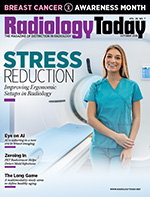 Editor’s Note: Proactive Imaging
Editor’s Note: Proactive Imaging
By David Yeager
Radiology Today
Vol. 26 No. 7 P. 4
I generally find that dealing with small problems before they become big problems, or, even better, heading them off before they become problems at all, is worth the effort. This is also an important aspect of medical imaging. We can detect more potential health issues sooner than ever before, and the technology is continually improving. But proactivity doesn’t stop with imaging. The ways in which images are acquired can be modified to produce better outcomes for radiologists and radiologic technologists. In this issue, we’re highlighting several ways that imaging and workflow can minimize or prevent significant problems.
Our cover feature examines the ergonomics of radiology. Radiologists and rad techs perform many repetitive tasks that can lead to overuse injuries, fueling burnout and staff attrition. Preventing these injuries is the most effective form of treatment, and Jessica Zimmer has tips for engineering workspaces to minimize repetitive use injuries while maximizing efficiency. Whether moving patients or reading studies, improvements in workstations, seating, and even computer mice can produce significant benefits.
In PET news, Keith Loria details a new technique for imaging mold infections. These infections are especially harmful in people with weakened immune systems. Mold infections are difficult to diagnose without performing a biopsy, but researchers at Johns Hopkins have seen promising results with an innovative imaging agent that has shown high sensitivity and specificity throughout the body. The researchers believe this technology can fill a significant gap in diagnosis and help identify infections sooner, improving treatment and outcomes.
AI is also helping to improve treatment and outcomes. Rebecca Montz has a closer look at how AI is changing multiple facets of breast imaging. It has already been shown to be a powerful tool for identifying breast lesions, but it can also improve workflow and even influence radiologists’ behavior by mimicking their eye tracking. However, AI is only as good as its implementation. The experts Montz spoke with for the article emphasize that AI should not replace humans. Rather, humans need to learn how to work with AI.
Finally, Beth W. Orenstein reports on a study being conducted at the University of Texas at Arlington that aims to evaluate healthy aging. The multimodality study, which has a significant imaging component, will collect data from 600 volunteers in an effort to determine factors that influence healthier aging among a diverse population. Study participants will have access to the data, which may help them identify potential health concerns when they’re more treatable. The researchers and other experts expect the study to yield a great deal of valuable information. For more details, turn to page 22.
Enjoy the issue.
— Dave Yeager
david.yeager@gvpub.com

